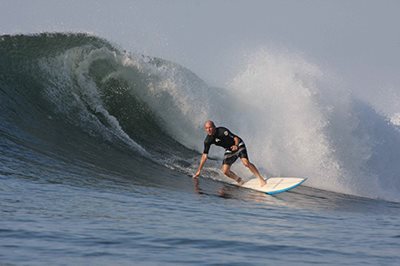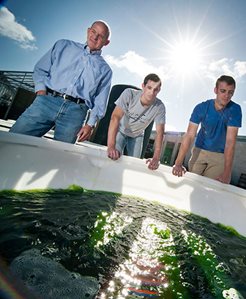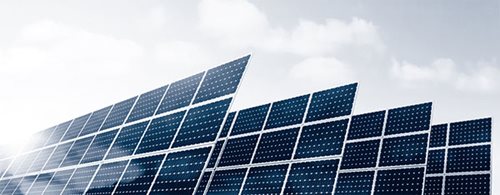2 February 2016
50 Voices of the Future: Stephen Mayfield on algae biotechnology

In honor of UC San Diego Extension's first 50 years, 50 Voices of the Future asks thought leaders about the trends, breakthroughs and social advances they foresee over the next 50 years.
Many of our daily products, from plastics to gasoline, are based in petroleum extracted from deep underground. What can we do when that supply runs low — or if the use of those products has harmful side-effects? Stephen Mayfield, a biotechnologist and professor of Molecular Biology, has an answer: Algae. Mayfield’s work, based at the California Center of Algae Biotechnology at UC San Diego, involves harnessing sunlight and atmospheric CO2 while programming algae for use in everything from vaccines to surfboards. The goal is to sustainably replace petroleum in an economically viable way.
(1) Why is the work you do important?
Our current path, requiring increasing energy and money to pull resources from the ground, is headed for collapse. It’s already happened in the fishing industry, where over-fishing has irreparably damaged the food chain. Meanwhile, omega-3 fatty acids made from algae in a farm-like environment can be sustained indefinitely.
 I view my job as twofold. One, I develop tools so anybody can use sustainable materials to make specific products such as therapeutic proteins, malaria vaccines, anti-cancer drugs, and even polyals (hydrophilic polymers) for making surfboards. I’ve founded companies — such as Sapphire Energy and Triton Health and Nutrition — that efficiently make these things daily. The second part of my job involves enabling the whole algae biotech industry to move forward.
I view my job as twofold. One, I develop tools so anybody can use sustainable materials to make specific products such as therapeutic proteins, malaria vaccines, anti-cancer drugs, and even polyals (hydrophilic polymers) for making surfboards. I’ve founded companies — such as Sapphire Energy and Triton Health and Nutrition — that efficiently make these things daily. The second part of my job involves enabling the whole algae biotech industry to move forward.
Stephen Mayfield, seen here catching a wave, collaborated with Arctic Foam to make this surfboard entirely out of polyols derived from green algae. Mayfield uses the surfboard as an example of algae's versatility.
(2) What are the influential/exciting developments in your field and why?
 I’m excited that we’re seeing more social acceptance for sustainable and renewable products. When I made a surfboard out of algal oil, it cost a little more to produce than a petroleum-based surfboard. If all people cared about was money, I’d be out of business quick. But now people see beyond the bottom line, realizing the many costs not factored into the selling price of petroleum-based products. We call those things externalities: pollution, mining by-products, tar sands and CO2 in the atmosphere. Thought processes are changing to: “Maybe I won’t water the lawn here in San Diego,” or “Maybe I can pay two dollars more for sustainable shoes, or for an environmentally farmed chicken.”
I’m excited that we’re seeing more social acceptance for sustainable and renewable products. When I made a surfboard out of algal oil, it cost a little more to produce than a petroleum-based surfboard. If all people cared about was money, I’d be out of business quick. But now people see beyond the bottom line, realizing the many costs not factored into the selling price of petroleum-based products. We call those things externalities: pollution, mining by-products, tar sands and CO2 in the atmosphere. Thought processes are changing to: “Maybe I won’t water the lawn here in San Diego,” or “Maybe I can pay two dollars more for sustainable shoes, or for an environmentally farmed chicken.”
Stephen Mayfield, with undergraduates Austin Hallgren and Nathan Schoepp, examines a UC San Diego experimental pond where a biofuel-producing green algae called Scenedesmus is thriving.
(3) What’s the next big thing?
Our tendency is to want Superman or a great leader to give us a simple solution, a “next big thing,” but change doesn’t work that way. Solving problems will take everybody getting together, each doing a little thing. The Internet and social media will help: In real time we can watch glaciers melting in the Sierras or pictures of water rising in Florida. People can see how easy it is to install solar panels or use electric cars. Already, in my own circle, I don’t know anybody who doesn’t have or isn’t considering adding home solar panels.
(4) How big of an impact will your field play in shaping the future of the San Diego region and beyond?
The algae biotechnology field nucleated with the academic labs here, Scripps and UC San Diego. Then companies like Sapphire, Synthetic Genomics and Cellana followed. It’s a funny thing: Once you build an ecosystem of research labs and investment community and biotech, then one little seed leads to rapid growth. I believe algae biotechnology is on the brink of a revolution. San Diego has become the planet’s epicenter for sustainability. Even across political lines, most San Diego leaders are embracing the science, the technology and the facts. It’s reflected in our transportation and environmental plans.
(5) Hop into your time machine…what does the future look like for this field in 50 years? How can individuals/companies prepare?
 Two words: Soylent Green. No, not like the movie — it’s not people! It’s algae. The future of agriculture will be built from algae products such as human-sustaining protein and great-tasting food. We’ll eat algae indirectly as well, using it to nourish fish and chicken. We’ll also see far better utilization of water. The trendy thing is to call it the energy-food-water nexus, with algae at the center. These rapid changes will happen in the next 20 years, nevermind 50. We’ll be harvesting algae for renewable polyurethanes, bio-plastics and pretty much everything you can imagine.
Two words: Soylent Green. No, not like the movie — it’s not people! It’s algae. The future of agriculture will be built from algae products such as human-sustaining protein and great-tasting food. We’ll eat algae indirectly as well, using it to nourish fish and chicken. We’ll also see far better utilization of water. The trendy thing is to call it the energy-food-water nexus, with algae at the center. These rapid changes will happen in the next 20 years, nevermind 50. We’ll be harvesting algae for renewable polyurethanes, bio-plastics and pretty much everything you can imagine.
If you want to prepare for tomorrow, however, there’s never been a better time to put up solar panels and harvest the sun.

You can learn more about the concepts Dr. Stephen Mayfield discusses in this article with several immersive programs offered by UC San Diego Extension. See our numerous Environment and Sustainability courses, as well as professional certificates in the fields of Algae Biotechnology Science and Biofuels Processes.